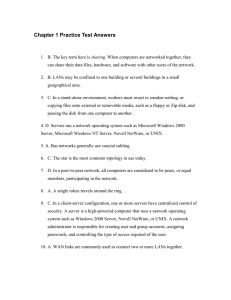www.ijecs.in International Journal Of Engineering And Computer Science ISSN:2319-7242
advertisement
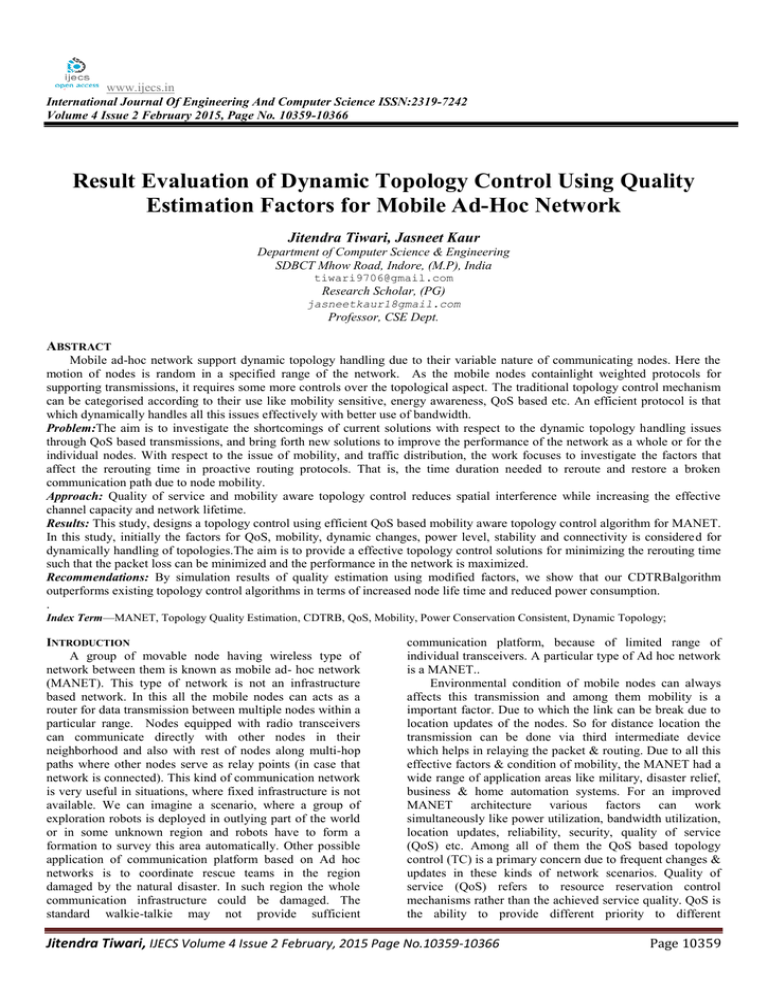
www.ijecs.in International Journal Of Engineering And Computer Science ISSN:2319-7242 Volume 4 Issue 2 February 2015, Page No. 10359-10366 Result Evaluation of Dynamic Topology Control Using Quality Estimation Factors for Mobile Ad-Hoc Network Jitendra Tiwari, Jasneet Kaur Department of Computer Science & Engineering SDBCT Mhow Road, Indore, (M.P), India tiwari9706@gmail.com Research Scholar, (PG) jasneetkaur18gmail.com Professor, CSE Dept. ABSTRACT Mobile ad-hoc network support dynamic topology handling due to their variable nature of communicating nodes. Here the motion of nodes is random in a specified range of the network. As the mobile nodes containlight weighted protocols for supporting transmissions, it requires some more controls over the topological aspect. The traditional topology control mechanism can be categorised according to their use like mobility sensitive, energy awareness, QoS based etc. An efficient protocol is that which dynamically handles all this issues effectively with better use of bandwidth. Problem:The aim is to investigate the shortcomings of current solutions with respect to the dynamic topology handling issues through QoS based transmissions, and bring forth new solutions to improve the performance of the network as a whole or for the individual nodes. With respect to the issue of mobility, and traffic distribution, the work focuses to investigate the factors that affect the rerouting time in proactive routing protocols. That is, the time duration needed to reroute and restore a broken communication path due to node mobility. Approach: Quality of service and mobility aware topology control reduces spatial interference while increasing the effective channel capacity and network lifetime. Results: This study, designs a topology control using efficient QoS based mobility aware topology control algorithm for MANET. In this study, initially the factors for QoS, mobility, dynamic changes, power level, stability and connectivity is considered for dynamically handling of topologies.The aim is to provide a effective topology control solutions for minimizing the rerouting time such that the packet loss can be minimized and the performance in the network is maximized. Recommendations: By simulation results of quality estimation using modified factors, we show that our CDTRBalgorithm outperforms existing topology control algorithms in terms of increased node life time and reduced power consumption. . Index Term—MANET, Topology Quality Estimation, CDTRB, QoS, Mobility, Power Conservation Consistent, Dynamic Topology; INTRODUCTION A group of movable node having wireless type of network between them is known as mobile ad- hoc network (MANET). This type of network is not an infrastructure based network. In this all the mobile nodes can acts as a router for data transmission between multiple nodes within a particular range. Nodes equipped with radio transceivers can communicate directly with other nodes in their neighborhood and also with rest of nodes along multi-hop paths where other nodes serve as relay points (in case that network is connected). This kind of communication network is very useful in situations, where fixed infrastructure is not available. We can imagine a scenario, where a group of exploration robots is deployed in outlying part of the world or in some unknown region and robots have to form a formation to survey this area automatically. Other possible application of communication platform based on Ad hoc networks is to coordinate rescue teams in the region damaged by the natural disaster. In such region the whole communication infrastructure could be damaged. The standard walkie-talkie may not provide sufficient communication platform, because of limited range of individual transceivers. A particular type of Ad hoc network is a MANET.. Environmental condition of mobile nodes can always affects this transmission and among them mobility is a important factor. Due to which the link can be break due to location updates of the nodes. So for distance location the transmission can be done via third intermediate device which helps in relaying the packet & routing. Due to all this effective factors & condition of mobility, the MANET had a wide range of application areas like military, disaster relief, business & home automation systems. For an improved MANET architecture various factors can work simultaneously like power utilization, bandwidth utilization, location updates, reliability, security, quality of service (QoS) etc. Among all of them the QoS based topology control (TC) is a primary concern due to frequent changes & updates in these kinds of network scenarios. Quality of service (QoS) refers to resource reservation control mechanisms rather than the achieved service quality. QoS is the ability to provide different priority to different Jitendra Tiwari, IJECS Volume 4 Issue 2 February, 2015 Page No.10359-10366 Page 10359 applications, users, or data flows, or to guarantee a certain level of performance to a data flow. Topology Control in MANET The topology of a multi-hop wireless network is a “set of communication links between node pairs used explicitly or implicitly by routing mechanisms”. A topology can depend on uncontrollable factors such as node mobility, weather, interference, noise as well as controllable factors such as transmission power, directional antennas and multichannel communications [1]. The topology control having good QoS will always depends upon various factors & consideration failure of which leads to wastage of utilization, channel capacity & communication cost. The design of this topology control should implicitly holds some characteristics for two major scenarios like if the topology is too sparse then the network can get partitioned. However, topology control can provide better control over network resources such as battery power and reduce redundancy in network communications. In MANET both of the above parameters can be used to understand the mobility principle effectively. Thus the mobility causes related movement of nodes which can break links and thus change the topology and this may result in partitioning of the network. Once the network is partitioned none of routing/broadcast protocol can be successful and very rare chances to form the connected network. For example [2], suppose node a and node b are neighbors in the network at time t, but somehow move out of the communication range at time t+Δt. During this period routing is unaware of this broken link and node a still forward packets to b and it will never reaches to node b. To keep the topology unchanged without disconnecting any node within the network needs topology management scheme. Effective Topology control will improve the performance and the capacity of Mobile Ad-hoc networks by building reliable network structure [3]. This work is focusing our research concern to both the above mentioned issues of QoS & topology control implementation of which expects the effective res Factors Affecting Topology Control It is shown that a number of factors can affect the efficiency of load balancing as listed below: Mobility Link Breaks Location Updates Level of asymmetry Offered load Level of spatial reuse Sensing range Shape and size of the network Location of gateways Network Energy QoS However, these factors alone cannot explain why the performance of topology control is high for certain networks while it is poor for others. Obviously, the specific layout of the topology is also an important factor. I. RELATED STUDY MANET is a type of dynamic changing nature & having a varying topology condition at various stages of transmission. There have been many research efforts to provide QoS support in MANETs. Various authors categorizes these efforts into QoS models, QoS resource reservation signaling, QoS routing, and QoS MAC, and provides an overview of how these different components can work together to deliver QoS in MANETs. In MANET, QoS based TC has no use of existing wired routing protocols. It requires specialized routing schemes which are classified into three categories based on topology update [7]: i) Table driven, ii) On-demand, iii) Hybrid routing protocols. The table driven routing protocol is also known as proactive routing protocol, in this protocol route to every node in the network is maintained in the routing table. Even if route is not required each node maintains the route to other nodes in the network. The simulation have used the network simulator ns-2 for simulating routing protocols using group mobility model, and present the results of simulations of networks of 40 wireless mobile nodes. Overall, the work conclude that under group mobility model, node's velocity has little impact, but number of FTP connections has significant impact on the performance of the routing protocols from QoS perspective. The DSR protocol emerges as the best in all respect. In most existing localized topology control protocols for mobile ad hoc networks (MANETs), each node selects a few logical neighbors based on location information, and uses a small transmission range to cover those logical neighbors. Transmission range reduction conserves energy and bandwidth consumption, while still maintaining network connectivity. However, the majority of these approaches assume a static network without mobility. In a mobile environment network connectivity can be compromised by two types of “bad” location information: inconsistent information, which makes a node select too few logical neighbors, and outdated information, which makes a node use too small a transmission range. Various approaches are proposed over the last few years which take this mobile topology change as a prime concern. In the paper [8] mobility-sensitive topology control method is proposed that extends many existing mobility-insensitive protocols. Two mechanisms are introduced: consistent local views that avoid inconsistent information and delay and mobility management that tolerate outdated information. A buffer zone mechanism guarantees (under low mobility) or enhances (under high mobility) the connectivity of the effective topology. At the analytical and mathematical evaluations level the works seems to be effective. In the paper [9] the author studied the effect of some new parameters of QoS on topology control. QoS is usually defined as a set of service requirements that needs to be met by the network while transporting a packet stream from a source to its destination. The network is expected to guarantee a set of measurable pre-specified service attributes to the users in terms of end-to-end performance, such as delay, bandwidth, probability of packet loss, delay variance (jitter), etc. The idea of leveraging node mobility to improve QoS can potentially be applied to any QoS-aware routing scheme. To demonstrate this idea, we chose to work with our modification of the AODV routing protocol, called QAODV, which enhances AODV to be aware of resource requirements. The first two fields specify the bandwidth requirements of the application and are populated by the source node. At the initial level of their simulation results it seems to be a effective mechanism. In this paper we presented a novel QoS architecture which enables real-time multimedia communication between peers in wireless mobile ad hoc networks.. During Jitendra Tiwari, IJECS Volume 4 Issue 2 February, 2015 Page No.10359-10366 Page 10360 this period of research the authors also focused on various interrelated issues of QoS based TC like peer to peer communication [10] in which a new protocol DACME is a probe-based admission control mechanism that performs end-to-end QoS measurements according to the QoS requirements of multimedia streams. However this is not a strict requirement, which means that DACME will still operate correctly in non QoS-compliant MANETs. Simulation results show that the probabilistic admission control technique used in DACME is effective at different levels of congestion, and that delay and jitter constraints are met with a good level of accuracy. Overall, DACME improves the performance experienced by users and also avoids wasting MANET resources. We observe that enhancing DACME with routing awareness further improves the performance achieved. In the paper [11] the author proposes a flexible QoS model for MANETs (FQMM) which considers the characteristics of MANETs and combines the high quality QoS of IntServ and service differentiation of DiServ. The idea behind IntServ is borrowed from the paradigm of the telephony world and B-ISDN, i.e., adopting a virtual circuit connection mechanism. The Resource ReSerVation Protocol (RSVP) is used as a signaling protocol to setup and maintain thevirtual connections. Routers apply corresponding resource management schemes, e.g., Class Based Queuing (CBQ) to support the QoS specifications of the connection. Based on these mechanisms, IntServ provides quantitative QoS for every o. Salient features of FQMM include: dynamics roles of nodes, hybrid provisioning and adaptive conditioning. Preliminary simulation results show that FQMM achieves better performance in terms of throughput and service differentiation than the best effort model. In case of multi-beam smart antennas, the network topology needs to be adjusted dynamically by adjusting the beam width and beam directions to minimize interference and to maximize the number of possible concurrent network communications.Thus the authorextends this concept to create an Adaptive QoS Topology Control (AQTC) [12] System using Smart Antennas. The network topology can be controlled in two ways: 1. Forming an initial fully connected topology during the network initialization phase and then changing the topology dynamically if required for new communications. 2. No initial connected topology is formed; the topology is formed dynamically depending on the communications. It uses a cross-layer approach to control the topology dynamically where the topology control layer sits between the MAC and the routing protocol. The performance of protocol has been evaluated using extensive simulations. AQTC always forms a topology to facilitate the current communications and improves the network throughput and end-to-end delay. Some of the authors also focused their work on cooperative communication. Most existing works on cooperative communications are focused on link-level physical layer issues. Consequently, the impacts of cooperative communications on network-level upper layer issues, such as topology control, routing and network capacity, are largely ignored. This paper proposes a Capacity-Optimized Cooperative (COCO) topology control scheme to improve the network capacity in MANETs by jointly considering both upper layer network capacity and physical layer cooperative communications [13]. When cooperative transmission is used, a best relay needs to be selected proactively before transmission. After obtaining the link capacity and inference models, the network capacity can be derived as the objective function in the topology control problem (1). The proposed scheme can determine the best type of transmission and the best relay to optimize network capacity. Simulation results have shown that physical layer cooperative communications techniques have significant impacts on the performance of topology control and network capacity, and the proposed topology control scheme can substantially improve the network capacity in MANETs with cooperative communications. So many other approaches for QoS is been proposed by various researchers. Some of these are given in [14] like adaptive routing, fair queuing, CADAR, Two level QoS, AOQR, QoS GRID etc. All this approaches made an intermediate decision at various layers of network model like physical, MAC, Network, transport & application. They all are dealing with dynamic environments having varying topology due to mobility of nodes. Generally, the QoS of any particular network can be defined as its ability to deliver a guaranteed level of service to its users and/or applications. QoS provisioning in MANETs typically involve the collaboration of various layers of the networking protocol stack, researchers are increasingly considering the use of cross-layered designs, adaptively, and mobility predictions to achieve QoS guarantees in the network. Nevertheless, there are still several outstanding QoS issues that must be addressed, and alternative forms of mechanisms must be studied in greater depth to facilitate the development of QoS in MANETs. Some of the authors had also worked on long distance topology control [15], QoS virtual backbone (QoS-VBB) [16], distributed admission control D-AC [17], for more than 15 hops of nodes. This contribution is concerned with the performance evaluation of topology control algorithms for indoor ad hoc networks in multi-storey buildings. Several proposed topology control algorithms based on discrete sets are compared. The topology control algorithms operate with wireless links having variable transmission rates according to existing wireless communication standards. The maximum number of routing steps is limited to 15 hops. Computational experiments with a queuing analyzer for open networks are performed to estimate the connectivity between distant nodes in the network located at different vertical levels. The tradeoff between connectivity and delay-throughput is studied assuming that the algorithms are constrained to the selection of only five links by each node. II. PROBLEM DEFINITION In existing TC protocols, the network is connected with all the nodes under the smaller range of transmission. In this every other node selects its nearest neighbors within its transmission range. This selection of neighbors is based on its nearest hop information of location, energy, connectivity & number of nodes. This grouping of short range neighbors nodes connected with each other is known as consistent topology. So its needs to be updated synchronously to the changing network conditions. During this changing condition some of the nodes can be moved out of the network & needs to be updated. The node which is still connected with above consistent group is known as active topology group. Also the parameters related to mobility had some of the QoS factors affecting to that directly. These must be taken into consideration with connectivity & power. Jitendra Tiwari, IJECS Volume 4 Issue 2 February, 2015 Page No.10359-10366 Page 10361 These discussion leads to three related issues in topology control which is still unsolved by any of the traditional mechanisms: (i) Most existing topology control algorithms assume homogeneous wireless nodes with uniform transmission ranges. When directly applied to heterogeneous networks, these algorithms may render disconnectivity. (ii) Taking the actual network condition under the connected transmission ranges, some methods needs to be given which ensures that consistent topology is generated from TC protocol. (iii) After considering this consistent topology how motion, connectivity, & power can be maintained for active topology condition. III. PROPOSED SOLUTION: CDTRB ALGORITHM Network changes very frequently due to movable nature of the nodes and hence their topology dependent activities get affected. This affection can be taken as transmission issues by which nature of network can be dynamically change. For handling of this sudden change in behaviour of the network connections is comes under the topology control process. This work proposes an modified CDTRB[18] with some robust result verifications topology control with quality parameters. Taking quality of service with topology control guides the network towards handling of dynamic behaviour of nodes with motion. The work considers various factors for updated topology detection and allotment and for this the parameters are mobility, energy and QoS. The approach is effectively handling all the issues related to better utilization of bandwidth using updated topology control. The suggested work is derived using a deeper survey of existing mechanism on above parameters and analytically evaluations of which proves the approach capability up to some extent. Here CDTRB stands for the parameters selected for effective topology control. The work uses connectivity, data transfer and residual bandwidth. The aim of taking these parameters is to consider the factor which affects most while the topology change. Here connectivity aims towards continuous connection status between any two consecutive nodes of the network. Data transfer identifies the amount of data is been transferred before nay topology change and remaining part of data to be send after the motion of nodes and change in topology. Residual bandwidth forecast the network capacity for transmitting the data in terms of size and hops of the network. The aim is towards assuring complete and stable connection till data transfer. The suggested approach is capable of dynamically handling all the topology situations using above parameters. The concern is towards accurately measuring the network capacity in terms of data transfer, power, and required bandwidth before applying any change to the network connections. If the information is updated then it is quite effective to tolerate any kind of data losses. There is also a alert system which guides the topology changes and predicts its after effect. As in network where the node mobility is high, the constraints related to energy and bandwidth must be effectively utilized and by the suggested CDTRB approach the aim is achieved. Architecture CDTRB Topology Control Node Connectivity Data Transfer Node Check Link Quality (Power) Node Node Dynamic Network (Old Topology) Data Collection For Sufficient Power Transmit the Packet Check Data Status Forward Complete Rcv Packet Wait: InComplete Rcvd Packet Node Residual Bandwidth Node Monitor Bandwidth Utilization Node Node Bandwidth Available > Required Dynamic Network (New Topology) DO Transmit Calculate Average Quality Path= (Route Existence (Connectivity and Power) + Data Status (Complete) + Residual Bandwidth)/3 Best Suited Path Selection (Average Quality Path>= Min Threshold) Update (Delete Old Path, Add New Path) Set Status to BiDirectional Figure 1: Proposed CDTRB Based QoS topology Control in MANET Components and Description: (i) Connectivity: Jitendra Tiwari, IJECS Volume 4 Issue 2 February, 2015 Page No.10359-10366 Page 10362 (ii) (iii) (iv) (v) (vi) (vii) Data Transfer: Residual Bandwidth: Data Collection: Average Quality Estimation: Best Path: New Topology Update: Flowchart Start 1 Set Initial Values Power Status Connectivity, Status, Bandwidth Transmission Checks Calculate Remaining Power Verify Path Value If (RemPow>Thr eshold) No Yes Data Status Search New Path No If (NRP==Full) Wait for Completion Update New Node Status== Completely Connected Yes Forwards Old Status 1 for Incomplete Packet Forwarding Status 0 1 3 Collect the Above Data for CDTRB Decision Link Status Residual Bandwidth Wait for Status Change Yes Calculate Average Quality Path Update All Routing Entries Continue Communication No If (Available Band >ReqBand) If (Flow==Accepted) No Link Quality<0 Yes Old Status 0 for Page 10363 Jitendra Tiwari, IJECS Volume 4 Issue 2 February, 2015 Page No.10359-10366 Link Quality Exit Link Quality=No New Link 3 The proposed CDTRB localized topology control algorithms maintains the network connectivity while reduces energy consumption and improved network capacity. These algorithms not only outperform existing approaches in terms of energy efficiency, network capacity, and several other performance metrics, but also provide certain performance guarantees such as the degree bound of optimality. The proposed approach works as an effective topology control mechanism taking QoS parameters as a major concern. Several problems and their corresponding solutions related to QoS topology control and strongly connectivity topology control in wireless ad hoc and sensor networks are discussed. Specifically, topics discussed include: (1) QoS topology construction algorithms in both homogeneous and heterogeneous networks with respect to different optimization objectives; and (2) how to construct strongly connected network topology under both non-restricted and restricted maximum transmission power. IV. CONTRIBUTION OF THE PAPER In this work implementation and analysis of topology control algorithms for mobile ad-hoc networks with emphasis on deployment on simulators fro studying the real affects of the suggested approach. The proposal and implementation of our algorithms using the customized models provide the solutions for end-user application without the need of any new network model or product to use or implement the required features. To solve the above problem of effective and dynamic topology control considering both QoS and mobility aware parameters, following steps have to be carrying out: (i) Identification of the best suitable approach to topology control problem in this particular arrangement of hardware components and scenarios. (ii) Evaluating the topology control using quality based estimations of data transmissions and energy constraints (iii) Dynamic handling of topologies connections with mobility based modifications (iv) The work also provides the identification of the usable configuration methods, built-in functions and limitations of hardware communication platform, which can influence the opportunity of the topology control. (v) The work also provides an implementation analysis of the suitable and reliable communication protocol. (vi) The simulations of QoS based traffic scenarios brought out the behavior and priority details in multi-hop network. used to evaluate the performance. For simulation purpose this work will use five performance metrics for showing the expected results. Results are plotted using Xgraph utility of NS2.To prepare simulation for desired network utility the following given network setup is provided. Table 1 Network Setup No of nodes 20 Radio-propagation Propagation/TwoRayGround Antenna model Antenna/OmniAntenna Routing protocol AODV Simulation dimension 750 X 550 Initial energy in Joules 1000 Simulation time 150 seconds Traffic TCP Channel type Channel/WirelessChannel Using TCL script the network scenario is created then Simulation is executed. And by using AWK file RREQ packets send, received is captured and also used for the remaining energy of the nodes. When the simulation starts then trace file and nam file generated. fig shown below is the scenario of the Wireless mobile ad-hoc network with six nodes. Figure 3: nam file of the network simulation. PDR (Packet Delivery Ratio) Graph Packet delivery ratio is the ratio of number of packets received at the destination to the number of packets sent from the source. The performance is better when packet delivery ratio is high. V. RESULT EVALUATIONS In this section the results of practical implementation will show the effectiveness of proposed scheme. For network simulation, there are several performance metrics which is Jitendra Tiwari, IJECS Volume 4 Issue 2 February, 2015 Page No.10359-10366 Page 10364 Graph 1: Comparison of PDR Ratio between existing and Proposed CDTRB Graph Summary: As the PDR ratio is used to identify the performance of the approaches using the packet delivery ratio. It is the ration of number of packet sent to the number of packet received. In ideal condition it should be high as possible. For comparing the suggested work of CDTRB, the above graph interprets the result as an improved PDR ration than the existing approaches. Throughput It is one of the dimensional parameters of the network which gives the fraction of the channel capacity used for useful transmission selects a destination at the beginning of the simulation i.e., information whether or not data packets correctly delivered to the destinations. Graph 3: Comparison of Routing Overhead between Existing and Proposed CDTRB Graph Summary: The above graph verifies its results by minimum routing overhead associated with the suggested approach. It also shows that the complexity of using the proposed method is quite less in comparison with the existing. Average End to End Delay This parameter works as an estimation of time required to completely deliver the packets from source to destination. For effective delivery it should be as low as possible. While comparing the values of existing from proposed, it is found that suggested CDTRB had lesser average end to end delay values which guarantees effective communication. Figure 4.1: Comparison of Average End to End Delay between Existing and Proposed CDTRB Graph 2: Comparison of Throughput between Existing and Proposed CDTRB Graph Summary: As throughput measure the transmission efficiency in terms of successfully delivered packets in unit time for a specified channel bandwidth. The above graph shows the effectiveness of the suggested approach while comparing it with the existing. The graph interprets the constant throughput for several cases which justify the approach. Routing Overhead Load Routing Load is the ratio of total number of the routing packets to the total number of received data packets at destination. The amount of control traffic generated (in bits) per data traffic delivered (in bits). It should be taken in terms of the extra load started while executing the suggested approach than the normal protocol load for the system.. Considering the factors Jitter Figure 4.2: Comparison of Jitter between Existing and Proposed CDTRB VI. CONCLUSION Various approaches had been proposed for topology control according to the requirements during the last few years. Among all of these QoS, Mobility & energy conservation based approaches is getting popularity day by day. To select the best one between them which satisfy all the user requirements is a typical task. Thus this paper gives a wide selection criterion after which it becomes easy to select better approach. Topology control in ad hoc network will dynamically improves the performance of the network by specific orientation of nodes towards these parameters of Jitendra Tiwari, IJECS Volume 4 Issue 2 February, 2015 Page No.10359-10366 Page 10365 quality. Among the various mechanism we have mentioned approaches for dynamic topology control with a hop-by-hop routing protocol which increases the network throughput and reduces the end-to-end delay. Thus to analyze the effective TC algorithms above mentioned metrics of QoS needs to be calculated. In this way the required TC can be find out. REFERENCES [1] Gaurav Srivastava, Paul Boustead, Joe F.Chicharo, “A Comparison of Topology Control Algorithms for Adhoc Networks”, in School of Electrical, Computer and Telecommunication Engineering, University of Wollongong, NSW, Australia. , [2] S. S. Dalu, M. K. Naskar & C. K. Sarkar, “Implementation of a Topology Control Algorithm for Mobile Ad hoc Networks Using Pursue Mobility Model”, in Journal of Applied Computer Science, ISSN:1843-1046, Vol (2), no.2, 2008, [3] S. Karunakaran and P. Thangaraj, “Topology Control Using Efficient Power Management”, in Journal of Computer Science, Science Publications, ISSN 15493636, Vol 7 , No 4:pp 561-567, 2011. [4] Rajneesh Kumar Gujral & Manpreet Singh, “Analyzing the Impact of Scalability on QoS-aware Routing for MANETs”, in IJCSI Issues, ISSN (Online): 1694-0814, Vol. 8, Issue 3, No. 1, May 2011 [5] Koushik Majumder & Subir Kumar Sarkar, “QOS Parameter Based Performance Study of the Gateway Discovery Approaches for MANET” in International Journal of Computer Applications (IJCA), 2011. [6] Surendra S. Dalu, M.K Naskar & C.K Sarakar, “ Hardware Implemenatation of a Topology Control Algorithm for MANET’s Using Nomadic Community Mobility Model”, in Journal of Theoretical and Applied Information Technology, 2009. [7] S. R. Biradar, Subir Kumar Sarkar & Puttamadappa, “Analysis QoS Parameters for MANETs Routing Protocols”, in (IJCSE) International Journal on Computer Science and Engineering, Vol. 02, No. 03, 2010. [8] Jie Wu & Fei Dai, “Mobility-Sensitive Topology Control in Mobile Ad Hoc Networks” in International Parallel and Distributed Processing Symposium,IPDPS- 2004 [9] Vishal Garg1 & Chandan Kapoor, “A Survey of QoS parameters through reactive routing in MANETs” in IJCEM International Journal of Computational Engineering & Management, ISSN (Online): 22307893, Vol. 13, July 2011. [10] Carlos T. Calafate, Juan-Carlos Cano, Pietro Manzoni & Manuel P. Malumbres, “A QoS architecture for MANETs supporting real-time peer-to-peer multimedia applications”, in Polytechnic University of Valencia (UPV), Valencia, Spain. [11] Hannan Xia, Winston K.G. Seah, Anthony Lo & Kee Chaing Chuaa, “Flexible Quality of Service Model for Mobile Ad-Hoc Networks”, in National University of Singapore. [12] Sk. Mohammad Rokonuzzaman, Ronald Pose and Iqbal Gondal, “A Cross-layer Approach for QoS Topology Control in Wireless Ad Hoc Networks” in IEEE , 978-1-4244-4547-9/09, 2009. [13] Quansheng Guan, Shengming Jiang, F. Richard & Yu, “Topology Control in Mobile Ad Hoc Networks with Cooperative Communications” Univ. of British Columbia, Vancouver, BC, Canada [14] Winston K. G. Seah, Hwee-Xian Tan, “Quality of Service in Mobile Ad Hoc Networks”, in IGI Global National University of Singapore, 2008. [15] Kitikun Poolsub, Benjaporn Lapwilai & Dobri Atanassov Batovski, “Topology Control for Long Distance Transmission in Multihop Ad Hoc Networks”, in AU J.T. 13(4): 213-222 ,Apr. 2010. [16] Moussa Ayyash, Donald Ucci & Khaled Alzoubi, “A Proactively Maintained Quality of Service Infrastructure for Wireless Mobile Ad Hoc Networks” in International Journal of Communication Networks and Information Security (IJCNIS), Vol. 2, No. 2, August 2010. [17] Pushpavalli M & Annitha N, “A Distributed Admission Control Based Quality of Service in MANET’s”, in International Journal of Engineering Trends and Technology,ISSN: 2231-5381 Volume 4, Issue 4- 2013. [18] Jitendra Tiwari & Jasneet Kaur. “CDTRB: QoS based Dynamic Topology Control for Ad-Hoc Network”, in International Journal of Computer Applications 82(1):44-49, Nov 2013. Jitendra Tiwari, IJECS Volume 4 Issue 2 February, 2015 Page No.10359-10366 Page 10366
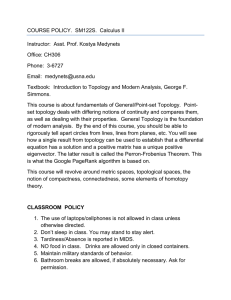

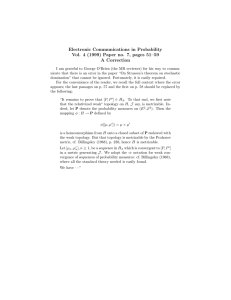
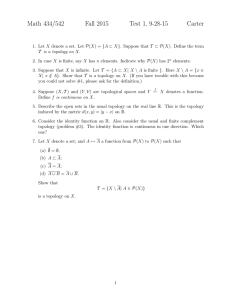
![MA342A (Harmonic Analysis 1) Tutorial sheet 2 [October 22, 2015] Name: Solutions](http://s2.studylib.net/store/data/010415895_1-3c73ea7fb0d03577c3fa0d7592390be4-300x300.png)

